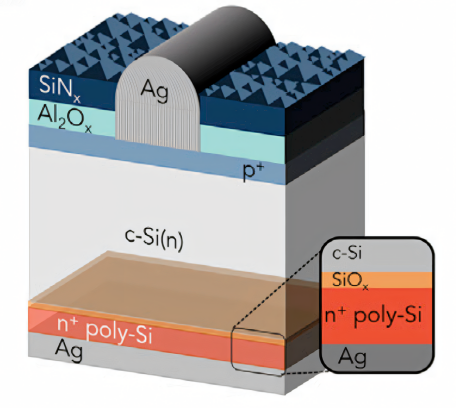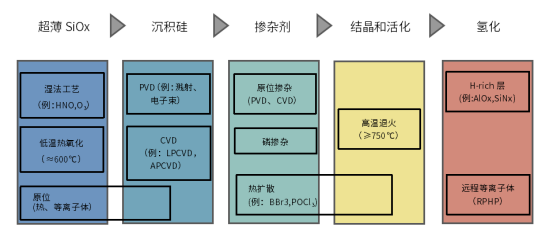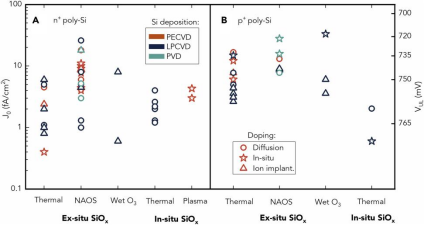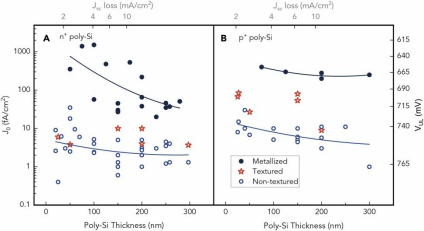
量子效率测试仪
PL/EL一体机
Sinton硅片少子寿命测试仪
Sinton硅块少子寿命测试仪
绒面反射率测试仪
3D共聚焦显微镜
清洗制绒工作站
在线四探针方阻测试仪
全自动扫描四探针方阻测试仪
在线薄膜厚度测试仪
晶化率测试仪
Horiba高速高分辨显微共焦拉曼光谱仪
傅里叶红外光谱仪
霍尔效应测试仪
分光光度计
全光谱椭偏仪
Horiba椭圆偏振光谱仪
TLM接触电阻率测试仪
超景深显微镜
网版智能影像测量仪
全自动影像测量仪
卧式拉力机
电池片稳态光衰老化试验箱
电池片紫外老化试验箱
电池片拉脱力综合测试仪
外观检验台
湿漏电测试系统
组件实验室EL测试仪
紫外老化试验箱
稳态光衰老化试验箱
电流连续性监测系统
PID测试系统
旁路二极管测试系统
LeTID测试系统
反向电流过载系统
脉冲电压测试系统
绝缘耐压测试仪
接地连续性测试仪
绝缘耐压接地测试仪
湿热环境试验箱
湿冻环境试验箱
热循环试验箱
动态机械载荷测试机
静态机械载荷测试机
冰雹冲击试验机
引出端强度试验机
霰弹冲击试验机
抗划伤(切割)测试机
剥离试验机
万能材料试验机(单臂)
万能材料试验机(双臂)
光伏玻璃透过率测试仪
醋酸测试试验箱
交联度测试系统
二极管接线盒综合测试仪
落球冲击试验机
半自动四探针
全自动探针式台阶仪
复合式LED模拟器
多通道太阳能MPPT系统
LED模拟器光浴
Horiba高灵敏一体式稳瞬态荧光光谱仪
钙钛矿P1激光划线测试仪
钙钛矿在线膜厚测试仪
钙钛矿工艺检测工作站
手持式IV测试仪
便携式EL测试仪
手持热成像测试仪
户外组件IV测试仪
户外组件多通道测试系统
光伏逆变器电能质量测试仪
无人机EL检测仪
Poly层厚度对TOPCon太阳能电池性能的影响
日期:2024-09-25浏览量:40
隧道氧化物钝化接触(TOPCon)技术是当今最具影响力和工业可行性的太阳能电池技术之一,其由超薄氧化硅层组成,夹在硅吸收层和掺杂Poly层之间。合适的Poly层厚度,可以在光学损失和电性能之间找到最佳平衡点,从而优化TOPCon电池的整体性能,提高电池的转换效率。美能在线Poly膜厚测试仪专为光伏工艺监控设计,帮助客户准确获得样品不同位置的膜厚分布信息,实时监控工艺的稳定性,从而优化薄膜厚度。
TOPCon 太阳能电池的结构

TOPCon 太阳能电池的横截面示意图
如图所示,TOPCon工艺是通过在c-Si硅片和高度掺杂的Poly层之间嵌入一层薄薄的绝缘层氧化硅(SiOx)形成的。这种结构的多晶硅钝化接触能够实现表面钝化和电荷载流子选择的功能,有助于提高太阳能电池的效率。
制备 Poly 层的主要步骤

制备Poly层的主要步骤
主要步骤:生长或沉积薄膜层→沉积硅/硅化合物薄膜→将掺杂剂掺入硅膜→硅的再结晶和掺杂剂的活化→氢化
在生长或沉积薄膜层步骤中,通常是SiOₓ通过将硅片浸入约 90°C 的热硝酸中化学生成自限制的约 1.4nm薄膜,或者在 550°C - 700°C 的氧气中进行短时间(约10分钟)的热氧化来生长约2nm的薄膜。该步骤中的技术工艺参数,如沉积时间、沉积速率等,会直接决定Poly层的厚度。
不同制备方法形成的Poly层

通过不同制备方法形成的Poly层
如图所示,表明不同界面氧化层制备技术对n+ Poly层和p+Poly层的复合电流密度(J0)和上限电压(Vul)的影响。
复合电流密度(J0):J0越低,表示Poly层的复合损失越小,电池性能越好。图中展示了不同界面氧化层制备技术(如热氧化、硝酸氧化、臭氧水氧化、等离子体氧化)对J0的影响。
上限电压(Vul):Vul是一个理论值,表示在没有复合发生时电池可以达到的最大开路电压。Vul越高,电池的理论效率潜力越大。
通过合理控制界面层和选择合适的制备技术,可以实现低复合电流密度的Poly层,为提高太阳能电池的性能提供了重要依据。
Poly层厚度对TOPCon电池性能的影响

Poly层厚度对复合和电流损耗的影响
图中分别展示了n+ Poly层和p+Poly层的复合电流密度(左轴)和上限电压(右轴)与Poly层厚度的函数关系,沉积的Poly层厚度会对结性能产生重大影响。
光子吸收损失:光子在多晶硅中被吸收会导致重组损失,掺杂多晶硅的吸收系数与晶体硅相似,当Poly层位于太阳能电池正面时,每 10nm 的多晶硅会导致短路电流密度损失约 0.4 - 0.5mA/cm²。
红外光子吸收:Poly层中存在的自由电荷载流子吸收红外光子,这种损失也会发生在Poly层位于电池背面时,对于140nm厚的Poly层,会导致约 0.3 - 0.5mA/cm²的损失(取决于掺杂情况)。
TOPCon电池中,Poly层的厚度会影响光子的吸收,过厚的Poly层会导致光子吸收增加,从而降低短路电流密度。因此,需要优化Poly层厚度以减少光学损失,Poly层的厚度会直接影响TOPCon的电池效率。
联系电话:400 008 6690
美能在线Poly膜厚测试仪,可完成薄膜厚度精确检测的同时,使电池厂商在沉积工艺产线中,运用该设备进行大规模的系统化检测,从而帮助电池厂商大大节约检测时间、提高生产效率与质量保证!
■ Poly膜厚测试范围20nm-2000nm
■ 快速、自动的5点同步扫描
■ 非接触、无损测量,零碎片率
■ 24小时自动且不停线校准,保证生产效率
Poly层厚度是影响TOPCon太阳能电池性能的重要因素,在电池设计和制造中需要综合考虑其对光子吸收、短路电流、复合电流密度等方面的影响,以实现电池性能的优化。美能在线Poly膜厚测试仪专为光伏工艺监控设计,帮助客户准确获得样品不同位置的膜厚分布信息,实时监控工艺的稳定性,从而优化薄膜厚度。






































































